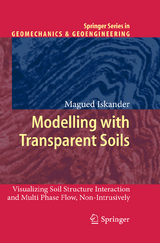Modelling with Transparent Soils
Visualizing Soil Structure Interaction and Multi Phase Flow, Non-Intrusively
Seiten
2012
|
2010
Springer Berlin (Verlag)
978-3-642-26355-2 (ISBN)
Springer Berlin (Verlag)
978-3-642-26355-2 (ISBN)
Arguing that transparent synthetic materials can be used to study 3-D deformation and flow problems in natural soils, this book presents the geotechnical behavior of many families of transparent soils that can be combined to meet model-test requirements.
up with automated systems for assessment of road condition. For example, Haas et al (1997) developed an automated algorithm for detecting cracks and joints con- tion. Smith and Lin (1997) developed a fuzzy logic classification scheme for pavement distress condition. Oh et al (1997) developed iterative algorithm for overcoming noisy images of roads due to shadows and low light conditions. Koustsopoulos and Mishalani (1997) presented a model for distress assessment in a local (microscopic) and global (macroscopic) level using captured images of pavement. Lee (1993) presented a comparison between 15 different imaging al- rithms used in crack detection. Ground Penetration Radar (GPR) has also been used for pavement assessment. Special computer algorithms were developed for quick analysis of GPR data (Adeli & Hung 1993 and Maser 1996). Heiler and McNeil (1997) proposed a modified system for analyzing the GPR data using an artificial neural network (ANN). 2.3.2 Traffic Analysis and Control Currently imaging systems provide essential data for transportation and traffic engineering planning (Anon 1999). Machine vision techniques were introduced to intersection traffic signal control in the late 1970's (Chou and Sethi 1993). No- days, many systems have been developed all over the world for traffic analysis and control applications, in addition to image based systems for traffic violations. Nallamathu and Wang (1997) developed one of the first automated systems for license plate recognition using character recognition algorithm for the use in monitoring violators at toll stations and many other traffic applications.
up with automated systems for assessment of road condition. For example, Haas et al (1997) developed an automated algorithm for detecting cracks and joints con- tion. Smith and Lin (1997) developed a fuzzy logic classification scheme for pavement distress condition. Oh et al (1997) developed iterative algorithm for overcoming noisy images of roads due to shadows and low light conditions. Koustsopoulos and Mishalani (1997) presented a model for distress assessment in a local (microscopic) and global (macroscopic) level using captured images of pavement. Lee (1993) presented a comparison between 15 different imaging al- rithms used in crack detection. Ground Penetration Radar (GPR) has also been used for pavement assessment. Special computer algorithms were developed for quick analysis of GPR data (Adeli & Hung 1993 and Maser 1996). Heiler and McNeil (1997) proposed a modified system for analyzing the GPR data using an artificial neural network (ANN). 2.3.2 Traffic Analysis and Control Currently imaging systems provide essential data for transportation and traffic engineering planning (Anon 1999). Machine vision techniques were introduced to intersection traffic signal control in the late 1970's (Chou and Sethi 1993). No- days, many systems have been developed all over the world for traffic analysis and control applications, in addition to image based systems for traffic violations. Nallamathu and Wang (1997) developed one of the first automated systems for license plate recognition using character recognition algorithm for the use in monitoring violators at toll stations and many other traffic applications.
Part 1 Introduction to Transparent Soils.- Part 2 Optical Techniques in Geotechnical Engineering.- Part 3 Introduction to Light and Optics.- Part 4 Optical Measurement of Strain and Stress.- Part 5 Geotechnical Properties of Transparent Silica Powders.- Part 6 Geotechnical Properties of Silica Gels.- Part 7 Geotechnical Properties of Aquabeads.- Part 8 Digital Image Correlation.- Part 9 Application of DIC for Measuring Deformations in Transparent Soils.- Part 10 Validation of Measured 2D Deformations.- Part 11 3D Deformation Measurement.- Part 12 2D Flow in Transparent Synthetic Soils.- Epilogue.- Appendix. Camera Calibration using Neural Networks.- References.- Index
| Erscheint lt. Verlag | 5.9.2012 |
|---|---|
| Reihe/Serie | Springer Series in Geomechanics and Geoengineering |
| Zusatzinfo | 335 p. 55 illus. in color. |
| Verlagsort | Berlin |
| Sprache | englisch |
| Maße | 155 x 235 mm |
| Gewicht | 532 g |
| Themenwelt | Mathematik / Informatik ► Mathematik ► Wahrscheinlichkeit / Kombinatorik |
| Naturwissenschaften ► Geowissenschaften ► Meteorologie / Klimatologie | |
| Technik ► Bauwesen | |
| Technik ► Maschinenbau | |
| Schlagworte | Centrifuge • Contaminant • Contamination • DNAPL • Fundament • Geomechanics • Geotechnical Engineering • Mechanics • Modelling • Model tests • Multi Phase Flow • NAPL • remediation • Soil Structure Interaction • Tank Tests |
| ISBN-10 | 3-642-26355-0 / 3642263550 |
| ISBN-13 | 978-3-642-26355-2 / 9783642263552 |
| Zustand | Neuware |
| Haben Sie eine Frage zum Produkt? |
Mehr entdecken
aus dem Bereich
aus dem Bereich
Buch | Softcover (2024)
Springer Spektrum (Verlag)
44,99 €
Eine Einführung in die faszinierende Welt des Zufalls
Buch | Softcover (2024)
Springer Spektrum (Verlag)
39,99 €




